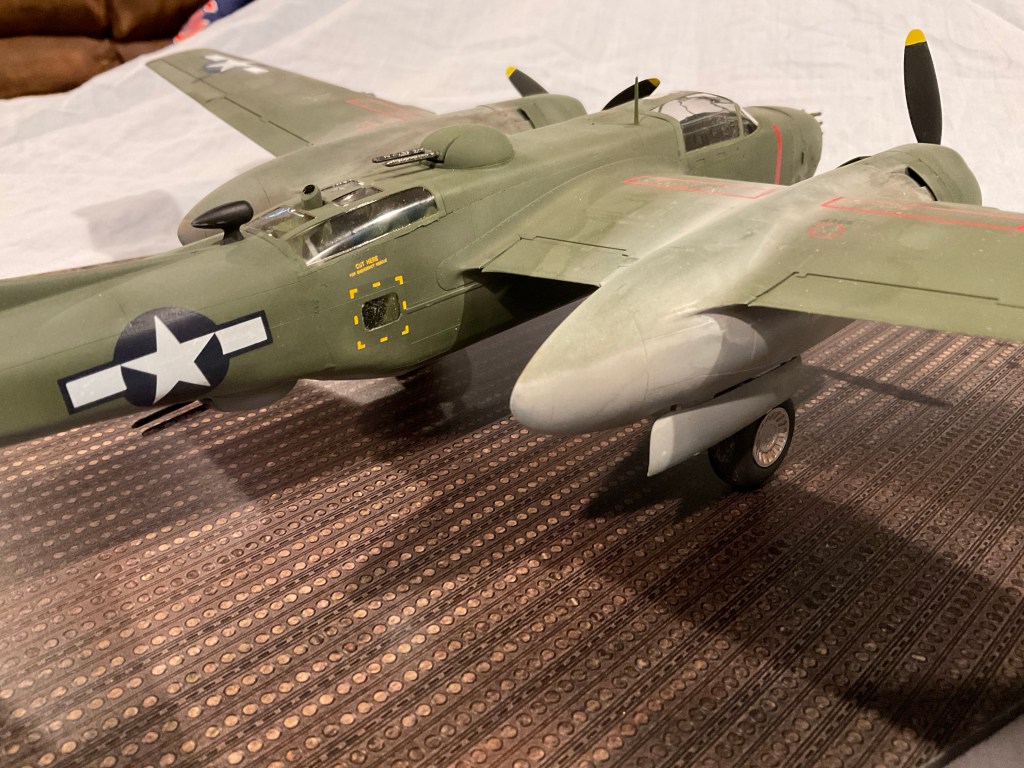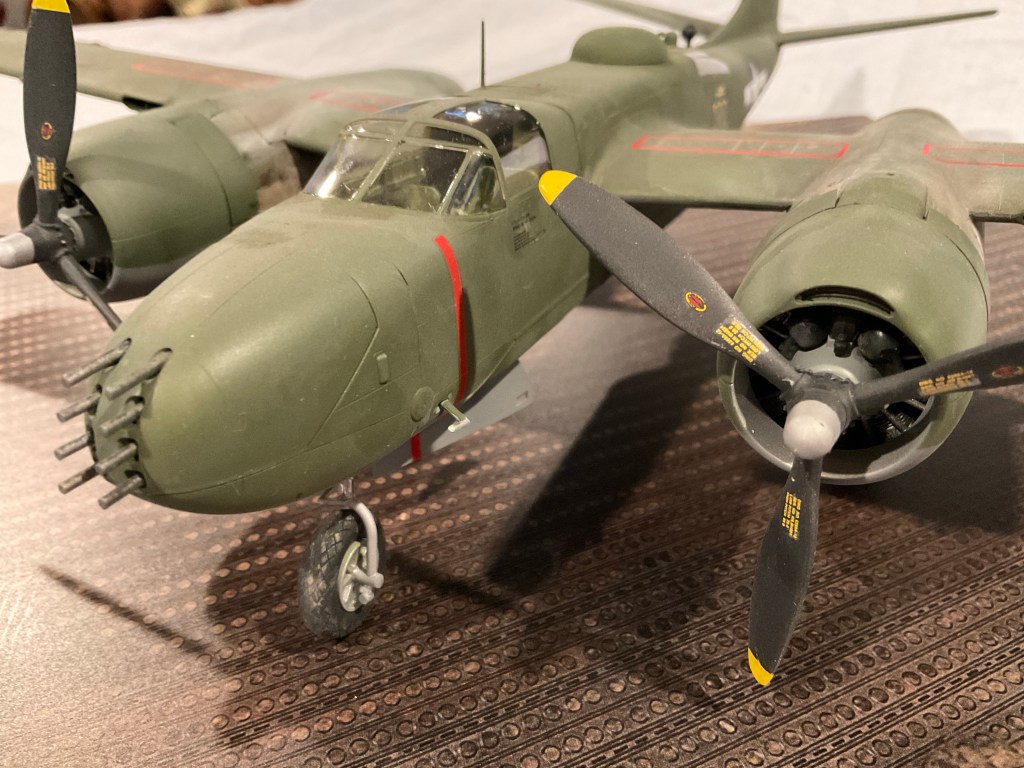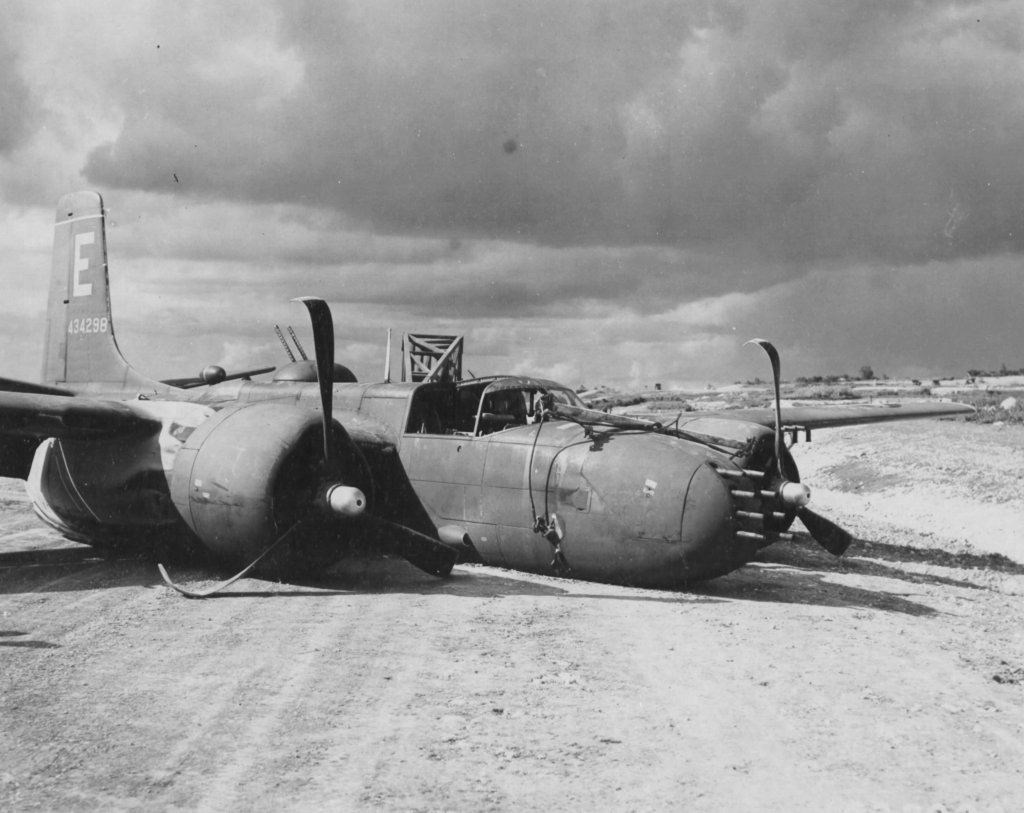The capable Invader was among the last new types to see service during World War II.

We’ll take a quick look at one from the last summer of the War.
The A-26 was designed by a team led by Ed Heinemann to replace his own A-20 already in service. It first flew on July 10, 1942.

It was given the “A” for attack designation to indicate it’s intended purpose of low-altitude, close support work. In US service that also meant it was a single pilot aircraft (no co-pilot). The initial intent was three main variants. The A-26A would be a night fighter, the A-26B a gunship/strafer and the A-26C with a clear, bomber type nose. It was quickly decided the night fighter role would go to other more fighter-like aircraft. The main production version would be the gunship.

The first version of the gunship mounted six .50s in the nose, and could carry one or two two-gun pods under each wing for up to 14 .50s firing forward. Towards the end of the War, this was redesigned with 8 .50s in the nose and three more in each wing; that’s a permanent mounting of 14 .50s. That is a lot of firepower.

The Army Air Force had big plans for the new type. It offered high performance thanks to a pair of R-2800 engines that could deliver over 2000 horsepower each for take-off; and a top speed over 350 mph. It could carry 6000 lbs of ordnance using both an internal bomb bay and underwing hard points. It was decided the new A-26 would replace all A-20, B-25 and B-26 aircraft on combat operations.

The first batch of service test aircraft were deployed to the South Pacific 5th Air Force summer of 1944. These were not well received. Pilots felt visibility from the new type was completely unacceptable, between a low profile canopy and huge engines right outside the pilot’s windows nothing below the aircraft could be seen easily. Commander of the 5th Air Force, General George Kenny, reported back to the Pentagon “we do not want the A-26 under any circumstances as a replacement for anything”.

Douglass did respond immediately with a new canopy design, much more window with a slight bulge, that helped a little. A follow up service test with the 9th Air Force in Europe went much better. Initial production went to Europe then, as a replacement for A-20 and B-26 types. The A-26C was slower getting into service, and many early adopters of the type continued to keep bomber nose A-20s around as formation leaders until almost the end of the War.
As production wound down on older types, the A-26 did see more service in the Pacific. With the visibility somewhat improved it came to be accepted, if not always enthusiastically. The preference in the Pacific seemed to be adding small flights of new Invaders into groups that were flying other types, several groups in the Pacific had anywhere from 4 planes to a whole squadron at the end of the War. Only the 319th Bomb Group, which entered combat February of 1945 was wholly equipped with Invaders. As an attack type, it was believed camouflage was important and Douglass continued to build Olive Drab over Grey aircraft for Pacific use long after everything else was being delivered in bare metal. One of my sources claims this was the ONLY AAF type still built in OD at the end of the War.

Many readers here may recall the A-26 Invader’s designation was changed to B-26 in 1948. Apparently the Air Force felt that since all B-26 Marauders had been retired at that point, they could change the designation (to better match its role) without causing confusion. 75 years later, I can only say that I’ll always include the name “Marauder” when talking about the B-26 because when we’re talking about WWII history it DOES cause confusion.
And a funny thing, when I was a kid I always kind of disliked the A-26 because it later stole the Marauders number. Silly right? I still don’t like the A-26…

This particular aircraft flew with the 3rd Bomb Group the last summer of the War. The 3rd had flown both A-20 Havocs and B-25 Mitchells, so the Invaders led to an even further mixed group. A few notes of interest, I’ve seen it mentioned that the 8-gun nose Invader was a post-War development. But that’s not true, I’ve seen photos of the later configuration in Wartime markings with combat damage. Also of (very minor) interest, the color “Olive Drab” changed during the War. Not only was the spec sort of loose, paint manufacturers only had to match a color chip, which was not rigorously policed; but the color chip changed. A “Dark Olive Drab” had been in use before the War, replaced with an ANA standard chip during the early neutrality period, and replaced again by what would be the post-War FS Olive Drab very late. This later OD is a little lighter and greener than the earlier shade. I believe the later standard OD was only used on A-26s produced for the Pacific. It might have also been at some late-War depots and shown up on some repair/modification work (I’ve assumed this to be true on a few previous builds… sort of hard to tell from old photos).
The 3rd Bomb Group was based in the Philippines and Okinawa for the last part of the War and transferred to Japan quickly after the surrender.

This is the ICM kit. As expected from a modern medium sized model, it was a complicated build but well engineered, so things fit well even if some of the complexity was a head scratcher. Like the inclusion of very difficult to mount exhaust pipes, that are completely hidden by the cowl flaps. It also includes a full bomb bay that I will build open on a later Invader. Late World War II Invaders would usually carry underwing rockets in the Pacific, but as this kit is a “Korean War” boxing it only includes bombs or drop tanks.
The decals are from Aeromaster.

I will stay with the Monogram Pro Modeler Invader I have in my stash as ICM model kits are much too complicated for “moi”.
They both have outline problems too, neither is perfect!
On balance, I like the tighter fit and better detail of the ICM kit. But yeah, I don’t think I’d worry about spending money for the newer kit if I had the older one on hand.
An interesting post about a less known aircraft. By coincidence, I recently came across a number of different A-26 conversions which turned them into high speed executive transports.
Interesting. I guess that makes sense, it was higher performance than most other types that would have been surplus. But kind of a tiny fuselage
Sorry about the delay. The types created from the A-26 were the……..
On Mark Marksman
Rhodes Berry Silver Sixty
Smith Tempo II
Lockheed Service Super 26
In at least one of these aircraft, the bottom of the original A-26 fuselage was amputated and a much more capacious replacement put in.
It makes sense to try, bomber shape is rarely ideal for passengers.
And of course, several were remanufactured into B-26K configuration which was the ultimate light attack-bomber version. It saw service into the 1960s that way.
The aircraft looks fantastic – outstanding post, Dave!
Thank you much! Filthy nacelles seems to be a constant for the type, so I had fun.
Great work on the models Dave! Thanks for the details especially on the OD differences.
Hey I’m glad you liked! Yeah OD is sort of a maddening color, between a vague spec and actual changes in the color to match it’s virtually impossible to ever get “right”. I suppose you could argue it’s just as hard to get “wrong”! The constant is inconsistency.
Ha! That’s how I feel with the US Navy and their shades of gray!
Their blue-grey is pretty bad too!
It certainly was a very potent machine. All those 50 cal guns would do a fair bit of damage to any target.
No doubt! That may be why its service life was over 20 years.
And deservedly so!